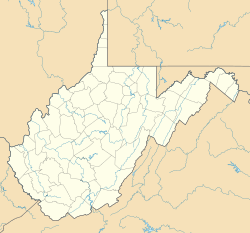Camp Bartow Historic District facts for kids
Quick facts for kids |
|
|
Camp Bartow Historic District
|
|
| Location | Jct. of U.S. Route 250 and WV 92 and WV 28, Bartow, West Virginia |
|---|---|
| Area | 182 acres (74 ha) |
| Built by | Peter D. Yeager, James Elliott |
| NRHP reference No. | 95001325 |
| Added to NRHP | May 10, 1996 |
The Camp Bartow Historic District is a special place in Bartow, West Virginia. It's centered around an old inn called "Traveller's Repose," which was rebuilt in 1869. This area was also the site of an important Civil War battle in 1861, known as the Battle of Greenbrier River.
The district is located at the foot of Burner Mountain. It's near a bend in the East Fork Greenbrier River. Here, U.S. Route 28 meets U.S. Route 250. This historic area was added to the National Register of Historic Places in 1996.
Contents
Exploring the Historic District
This historic district includes many old buildings and important historical spots. The main house, "Traveller's Repose," was built in 1869. It's a two-story house that was made bigger in 1912 and again in 1928.
Other buildings on the property include a barn from 1925. There's also a well house and woodshed from around 1930. You can find a cellar house from the 1870s and a corn crib from the 1940s. A storage building from the 1920s is also part of the site. Nearby, there's another barn from 1910 and a garage from 1940. The district also includes the Yeager Cemetery.
The district also holds important sites from the American Civil War. On October 3, 1861, the Battle of Greenbrier River happened here. You can still see four main forts with trenches and places for cannons. There are two more cannon spots and old camp areas. An unmarked cemetery holds the graves of 82 Confederate Army soldiers. A part of the old Staunton and Parkersburg Turnpike is also in the district. This road was built between 1838 and 1846.
Traveller’s Repose Inn
A Historic Stop for Travelers
The "Traveller's Repose" inn was a famous stop for many years. It served people traveling on the Staunton-Parkersburg Turnpike. It was known as the first stagecoach stop west of Allegheny Mountain.
Andrew Yeager (1800-1861) owned and managed the inn starting in 1845. His father, John P. Yeager, Sr., came to the area around 1795. The Repose also became Pocahontas County's first post office from 1847 to 1906. The two-story wooden farmhouse you see today was built in 1869.
The inn became important because of the turnpike. Construction on the road began in 1838. By 1845, the road was long enough that an inn was a good idea. When the mail route started in 1847, Traveller's Repose became the post office too.
The Civil War and the Inn
In September 1861, Confederate soldiers set up camp nearby. On October 3, the inn was caught in the middle of the Battle of Greenbrier River. The forts were named Camp Bartow after a Confederate commander, Col. Francis S. Bartow. These forts are still mostly in place today. The town itself later became known as Bartow.
Later that winter, some fighters burned the Repose. This meant neither side could use it. The Confederate soldiers then moved about five miles east to Camp Allegheny. They wanted to keep control of the turnpike. On December 13, they stopped a Union attack at this new spot. This helped them keep control of the road.
However, this came at a cost. An unmarked grave on the property is said to hold the remains of over 80 Confederate soldiers. They died from their wounds, sickness, and the cold that winter.
Rebuilding and New Stories
In 1869, Peter Dilly Yeager (1829-1906) rebuilt Traveller's Repose. He was Andrew's son and had been a prisoner during the war. The new inn had 22 rooms for guests. It also had space for 28 horses in the barn. It was sometimes called the "Yeager Hotel" or the "Greenbrier Hotel."
Brown Buren Beard (1883-1969) bought the Repose in 1912. His daughter, Jessie Beard Powell (1915-2013), lived at the Repose for all 97 years of her life. She loved to share stories from the old days. One story was about 1,200 Rebel soldiers. They cut down 500 of her family's sugar maple trees for military use.
Local stories say that Abraham Lincoln stayed here on his trips. Other famous people, like Stonewall Jackson, are also said to have stayed at the Repose. However, there isn't much proof for these stories.
The Repose was still offering "lodging and meals" around 1940. Writers from the WPA visited the area then. In 2014, after Jessie Beard Powell passed away, the property was sold. It then left the family's hands.




